 Creepy
Creepy  Creepy
Creepy  Movies and TV
Movies and TV 10 Movies That Get Elite Jobs Right, According to Experts
 Weird Stuff
Weird Stuff 10 Times Real Laws Were Based on Bizarre Hypotheticals
 Animals
Animals 10 Inspiring Tales of Horses Being Human
 Mysteries
Mysteries Top 10 Haunting Facts About the Ghost Ship MV Alta
 History
History 10 Surprising Stories About the Texas Rangers
 Humans
Humans 10 Philosophers Who Were Driven Mad by Their Own Theories
 Miscellaneous
Miscellaneous 10 Video-Game-Worthy Weapons and Armors from History
 Weird Stuff
Weird Stuff 10 Psychics Who Accurately Predicted Wartime Events
 The Arts
The Arts 10 Pieces of Art Inspired by a Broken Heart
 Creepy
Creepy 10 Death Superstitions That Will Give You the Creeps
 Movies and TV
Movies and TV 10 Movies That Get Elite Jobs Right, According to Experts
 Weird Stuff
Weird Stuff 10 Times Real Laws Were Based on Bizarre Hypotheticals
Who's Behind Listverse?

Jamie Frater
Head Editor
Jamie founded Listverse due to an insatiable desire to share fascinating, obscure, and bizarre facts. He has been a guest speaker on numerous national radio and television stations and is a five time published author.
More About Us Animals
Animals 10 Inspiring Tales of Horses Being Human
 Mysteries
Mysteries Top 10 Haunting Facts About the Ghost Ship MV Alta
 History
History 10 Surprising Stories About the Texas Rangers
 Humans
Humans 10 Philosophers Who Were Driven Mad by Their Own Theories
 Miscellaneous
Miscellaneous 10 Video-Game-Worthy Weapons and Armors from History
 Weird Stuff
Weird Stuff 10 Psychics Who Accurately Predicted Wartime Events
 The Arts
The Arts 10 Pieces of Art Inspired by a Broken Heart
10 Ways Slaves Will Work For You Today
Slavery came to an end in 1865, and the world never had to deal with the ugliness of forced labor ever again. Sadly, only part of that sentence is true. The sad fact is, only the African Slave Trade ended in 1865, and modern slavery isn’t just on the rise . . . it’s far larger in scope than in the past.
SEE ALSO: 10 Ways American Slavery Continued Long After The Civil War
Modern estimates of slavery suggest as many as 40,000,000 people are trapped in one type of forced labor or another. While men and women are often equally forced into slavery, children are often the most victimized. They have had their dreams and their childhood stolen.
Because it’s so widespread, the average person benefits from it, whether they like it or not. A lot of what we think of slavery stems from the 19th century, but modern slavery is different in many ways; it’s dynamic, affects a wide swathe of people, and is used to make the products and services we take for granted.
10 Seafood

The United States and the rest of the western world enjoy seafood from around the globe, but it’s not always caught by people who are willing or paid for their labor. Often, people desperate for work answer advertisements suggesting great pay and benefits for positions working on fishing boats, and though the offers may appear to be too good to be true to some, others fall victim to a trap. Bloomberg published an article back in 2012 titled, “Slaves Put Squid on Dining Tables From South Pacific,” which detailed the process by which desperate people find themselves in a modern version of indentured servitude they cannot escape.
The drive for seafood slavery is all about American and other western demands for more seafood. The demands on the fishing industry has increased steadily since the mid-1990s, and despite a reduction in global stocks, demand has risen, which in turn leads to cuts in cost. Sadly, those cuts are often in the form of slave labor, and the people trapped on those vessels are often subjected to dangerous and often deadly conditions, which are exacerbated by their isolation on the open sea. Slavery in the market isn’t limited to the boats, and many people are working without pay in seafood processing plants and throughout the aquaculture industry.
What You Can Do—To reduce global seafood slave labor, you need to ensure your seafood comes from a reputable source. Research where you get your seafood, and never purchase from a company that receives its catch from a dubious source.[1]
9 Cannabis

Like other drugs, marijuana is not free from the crimes of slave labor, and despite growing popularity and legality around the world, there are an estimated 10,000 to 13,000 victims of slavery working in the United Kingdom’s cannabis industry. Children are often brought into the industry from outside of the U.K., most often from places like China and Vietnam. One sixteen-year-old victim who was trafficked into the cannabis industry said of the man who took him, “I remember asking the man who took me there if I could leave because I didn’t like it, but he threatened to beat me or starve me to death.”
Children are used in the industry, in part, because they are easily convinced that their families will be killed if they don’t do what they’re told. Most live in squalid conditions, and they are denied basic human rights, including an education. Many of the children enslaved in this way are kept from the public, but some are forced to work outdoors where people drive by without suspecting anything is wrong. One of the biggest problems is, if a child is caught up in a drug bust, they can be charged with committing a crime, which is exactly what happened to the sixteen-year-old victim quoted previously. “The police charged me with drug offenses, and I was sentenced to 18 months in a young offenders’ institute.”
What You Can Do—There will always be a market for slaves where a demand for illegal drugs exists. If you live in a place where cannabis is illegal, don’t buy it. Doing so keeps the demand in place, keeping slavery alive. Alternatively, you can lobby your government to decriminalize marijuana, as many states in the US have done.[2]
8 Fashion
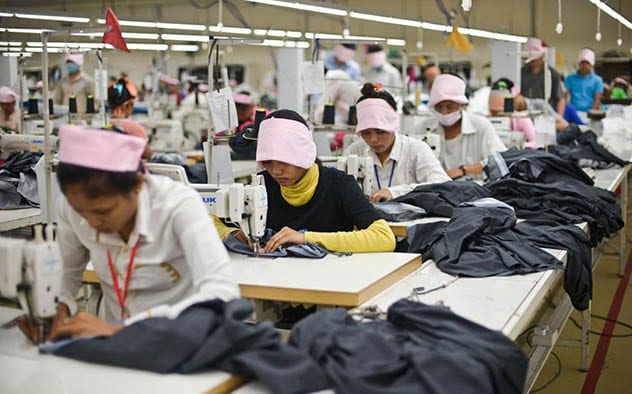
One of the biggest abusers of modern slavery across the globe is the garment industry. Throughout much of Asia and Africa, people are forced into slave labor to provide the world with cheap, easy, and abundant fashion garments and accessories. Because fashion is one of the most labor-intensive industries around, a relatively small, yet skilled amount of people are forced to work long hours to produce huge quantities of products. The countries that make up the G20 imported $127.7 billion in fashion garments the Global Slavery Index identified as being “at-risk” of production from slave labor.
The people who are working to make the rest of the world look trendy are often subject to little or no pay, forced unpaid overtime, dangerous conditions, and a degraded economy due to an inability to compete. One of the biggest problems with the industry is overproduction. The Ellen MacArthur Foundation estimated that the fashion industry produces around 53 million tons of fiber each year, but 70% of that ends up in landfills. Overconsumption leads to overproduction, and that increases the risk and use of slavery, which means most everyone reading this has benefited from it at least once in their lives without ever realizing it.
What You Can Do—There are several steps the average person can take to undercut the use of slave labor in the fashion industry. First, wear what you have and don’t buy new items when you don’t need them, which is also good financial advice. Find out where and how your clothes are made. If a company is suspected of using slave labor, don’t buy from them and instead, support ethical producers who pay their employees a fair wage.[3]
7Firefighting
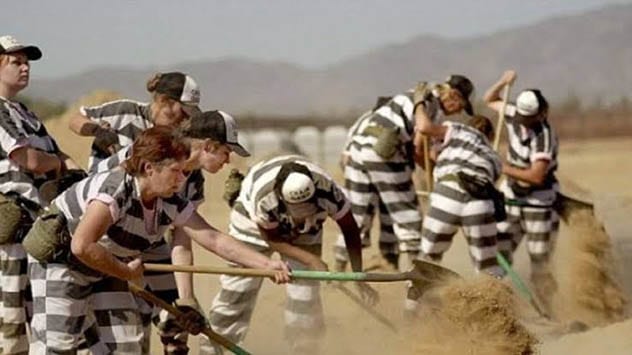
When the United States outlawed slavery via the 13th Amendment to the U.S. Constitution, a single phrase was written into it, allowing for the continued enslavement of prisoners. That line reads, “Neither slavery nor involuntary servitude, except as a punishment for crime whereof the party shall have been duly convicted…” Essentially, this means a person can be forced to work as slave labor, often called “prison labor” by the state or federal government, and they have taken advantage for more than 150 years. Prisoners are given work to do while in custody, but they are often paid so-called “slave wages,” amounting to pennies on the hour. While many people feel that they no longer deserve to be exempt from slave labor because they broke the law, just as many people are on the opposite side of the argument, arguing for their basic human rights.
One of the ways millions of people benefit from this form of labor is in the fighting of California’s yearly wildfires. Inmates who volunteer for firefighting work are paid $1 an hour, plus an additional $2 per day, and while they are both volunteers, and are compensated, the dangerous conditions and lack of proper financial compensation is tantamount to slave labor. “Today, more than 2,000 volunteer inmate firefighters, including 58 youth offenders, are battling wildfire flames throughout CA. Inmate firefighters serve a vital role, clearing thick brush down to bare soil to stop the fire’s spread.”
What You Can Do—While everyone should practice the safe use of matches and other implements that can cause wildfires, there are some things a regular person can do to help. Volunteer at your local fire department, and while this won’t stop prison labor in terms of firefighting, it will help the people fighting the fires and reduce the need for prison labor. Additionally, you can petition the California government to stop the use of penal labor, specifically focusing on dangerous activities like firefighting.[4]
6Batteries
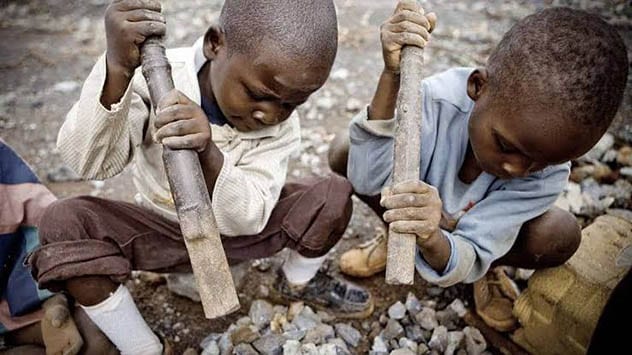
Yes, the battery in your cell phone or electric car may have sent some cash into the pockets of slave traffickers, and the problem is growing as demand for lithium and cobalt increases. Most of us think of batteries as a simple modern convenience, but they rely on the mining of mass quantities of lithium and cobalt with the need expected to double before 2024. Mining anything is difficult and dangerous work, but the mining of these two elements, specifically for use in batteries, often use child labor and results in the undermining of local land and water rights, which harms the local environment, leading to widespread disease and malnourishment among indigenous populations.
Just in the Democratic Republic of Congo alone, there are an estimated 40,000 children forced into slave labor working to pull cobalt out of the ground. Not only are many of the kids working in the mines underpaid or not paid at all, the conditions are terrible, amounting to little more than human rights abuses. Children as young as six-years-old have been found working in the mines, where they are forced to work without safety equipment, which would protect them from toxic dust.
What You Can Do—Unfortunately, it’s difficult to determine whether or not your battery has been made from cobalt or lithium sourced via slave labor. The best way to fight against this ongoing problem is to raise awareness with large electronic firms, so their products aren’t being made with materials from known or suspected sources of slave labor. Check with Amnesty International for more information.[5]
5 Diamonds
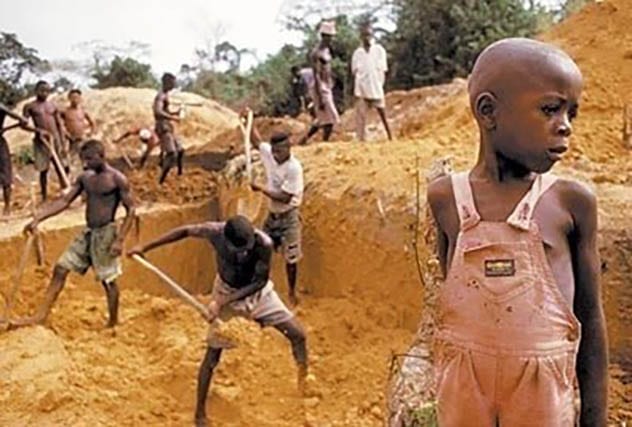
Diamonds are one of the most heavily trafficked gemstones in the world, and because they come from locations often embroiled in a civil war, some diamonds have been labeled as “conflict” or “blood diamonds.” The term has become popular in the 21st century to specifically refer to diamonds mined in Angola, Ivory Coast, Sierra Leone, Liberia, Guinea, and Guinea Bissau, all of which have had horribly catastrophic civil wars in recent years. The mining of diamonds in these areas often goes to fund an ongoing insurgency, hence the name, but the conflicts aren’t the only thing that makes these diamonds a problem. Many of the indigenous people caught up in the region are forced to mine the diamonds as slaves, which make the gems particularly problematic.
Many of the enslaved people forced to collect diamonds are children, and the ones who aren’t sent to the mines are often sent to war. This has been especially problematic in Sierra Leone, which has been second-to-last on the UN Human Development Index. Of course, that’s not the only example, as thousands have been enslaved and killed in Zimbabwe and elsewhere, even when there is no conflict present.
What You Can Do—Never buy a diamond sourced from the countries listed, and ask where your jeweler sources their diamonds before making any purchases. Fortunately, there are plenty of sources that use legitimate labor, but if you’re still unsure, look into another gemstone, cubic zirconia, or a manufactured diamond.[6]
4 Coffee
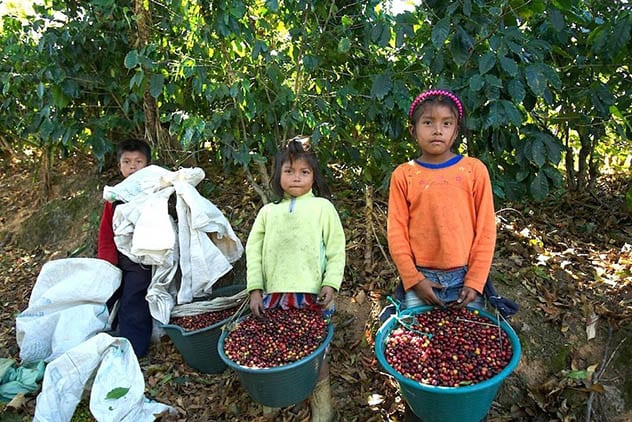 Coffee has long been a staple of the modern world, and many people can’t imagine going a single day without their beloved cup of Joe. Sadly, it’s due to the massive demand for coffee that a rise in production has pushed many in South America into slave labor. If you think there’s no way that the coffee you buy has been sourced from slave labor, you’re probably right, but not always. In September 2018, it was determined that a Brazilian coffee plantation previously certified to be slave-free by Starbucks, was found to have 15 enslaved people trapped in conditions analogous to modern slavery.
Coffee has long been a staple of the modern world, and many people can’t imagine going a single day without their beloved cup of Joe. Sadly, it’s due to the massive demand for coffee that a rise in production has pushed many in South America into slave labor. If you think there’s no way that the coffee you buy has been sourced from slave labor, you’re probably right, but not always. In September 2018, it was determined that a Brazilian coffee plantation previously certified to be slave-free by Starbucks, was found to have 15 enslaved people trapped in conditions analogous to modern slavery.
One of the largest groups of people employed illegally in the coffee industry probably won’t surprise anyone: it’s children. Because Brazillian coffee workers earn only 2% of the retail price of the product they help bring to market, many have pulled their children from school to put them into working cultivation. This results in a recurring problem, seeing as a higher education leads to better wage-earning jobs, but the children forced to cultivate coffee for no money often fall victim to the same problems their parents faced when they were children, leading to a cyclical problem.
What You Can Do—When you buy coffee, ask where it’s sourced. If the Brazilian example above is any indication, any plantation could become a perpetrator of forced labor, so continue to ask and research the places your coffee comes from before making a purchase.[7]
3Gold
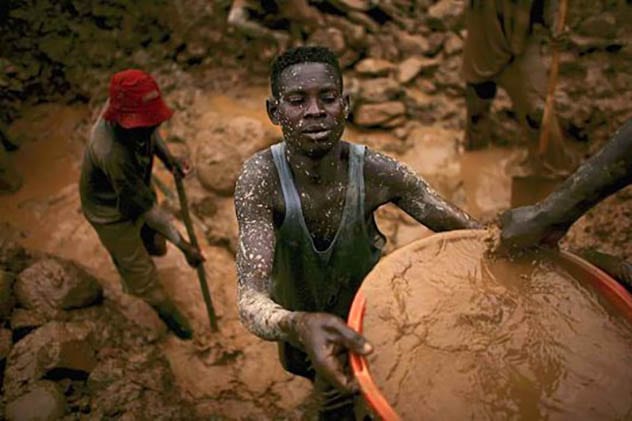
Gold has been a major economic commodity since the beginning of human history, and like anything inherently valuable, it’s subjected to the same pressures of supply that put many of the items on this list. Gold slavery is a significant problem since mining gold has moved into some of the least-developed and poorest nations in the world. This leads to a reduction in regulation, worker safety, child labor laws, and human rights. Gold slavery is one of the most widespread forms of slavery, and it can be found in places like North Korea, but it is also prevalent throughout Africa, South America, and Asia.
Thousands of people work in mines around the world to pull near-microscopic amounts of trace gold from the ground—the work is difficult, dangerous, and often the result of a form of indentured servitude. In order to mine the gold, the workers are required to pay for their equipment, and any gold they mine goes toward that payment, but the system is rigged such that they will never pay it off, resulting in their enslavement. Others are trafficked into gold mining where they receive only food until they pay back their trafficker as much as nine grams per week for up to two months before they’re let go… and they are the lucky ones. Gold mining doesn’t produce the shiny metal solely for the jewelry industry, and because it’s used in numerous electronics devices, you may have slave-mined gold in whichever device you’re using to read this article.
What You Can Do—It’s difficult to find out whether or not your electronics contain gold sourced from slave labor, but there are places you can check. Just as you should with diamonds, ask your jeweler where their gold is sourced, and make sure whatever purchases you make come from informed decisions.[8]
2 Chocolate

Sadly, one of the best foods on the planet is sometimes sourced through slave and/or child labor in numerous countries, including Brazil, Cameroon, Ghana, Guinea, Sierra Leone, Côte d’Ivoire, and Nigeria. In Côte d’Ivoire and Ghana, there are an estimated 2.3 million children who work in the cocoa fields, many of them do so against their will with no pay, which results in widespread poverty. The problem is well known to all the major candy companies, including Nestlé, Hershey, Cargill, ADM, and Barry Callebaut, all of which admitted accountability in 2002, but the problem persists.
The average earnings of a cocoa farmer in Western Africa amount to around $2 per day, which is little to nothing when it comes to taking care of families. Like the people tricked into working the seafood industry, many unsuspecting people are taken in by traffickers, and they may never escape the brutal conditions of their enslavement. Since cocoa makes up a significant percentage of many poor African nation’s exports, the demand for cheap/unpaid labor continues to grow.
What You Can Do—Like the rest of the products on this list, you want to do some research before purchasing cocoa you consider suspect. For the most part, the brands listed above have made strives to limit sourcing from places that use slave labor, but more can be fone. Do some research if you’re concerned, and stay informed about your purchases.[9]
1The Adult Industry

Don’t jump the gun; we’re not suggesting our readers patronize prostitution; rather, adult content found online and in magazines. Let’s face it, it isn’t one of the largest industries on the planet if nobody is buying it, but there’s a serious problem with adult content due to human trafficking, which is one of the most pervasive forms of slavery in the world today. The victims are men, women, and children who make up nearly a quarter of enslaved people worldwide. It is estimated that as many as 4,500,000 people are in some form of forced sexual slavery as of 2010, and the problem continues to grow.
Simple pictures advertising something considerably benign like a cam show or call-in “party line” may use images of people who had no say about being photographed or used in such a way while many of the models in those same shows may not be there by choice. Thousands of those same people are forced to do things with men (and women) against their will, and the most vulnerable people subjected to this practice are young runaways. They are picked up by traffickers in the United States and across the globe where they are forced to do things against their will in horrific conditions, often requiring them to ‘perform’ dozens of times a day.
What You Can Do—There are organizations all over the world that work to stop the practice of using enslaved people in the online adult industry. You may not be able to tell yourself, so it doesn’t hurt to check with a nonprofit or government agency to ensure you aren’t viewing something online that is the result of human trafficking.
Ultimately, the most important thing anyone can do if they suspect someone is being used in one form of slave labor or another is to alert the authorities.[10]
For more lists like this, check out Top 10 Whites Who Stood Up Against Slavery, and 10 Black People Who Acquired Wealth During Slavery.








